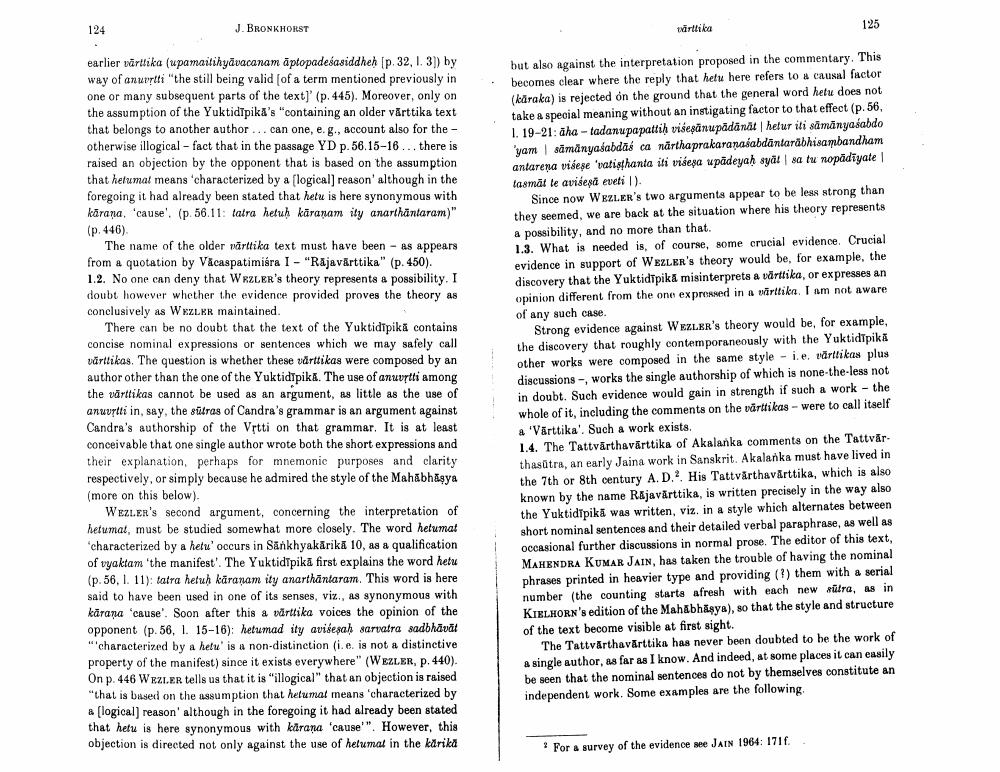Book Title: Archiv Fur Indische Philosophie Author(s): Johannes Bronkhorst Publisher: Johannes Bronkhorst View full book textPage 2
________________ 124 J. BRONKHORST tarttika 125 earlier wirtlika (upamaitihyāvacanam aptopadešasiddheh (p.32, 13]) by way of anurrtti "the still being valid (of a term mentioned previously in one or many subsequent parts of the text]' (p. 445). Moreover, only on the assumption of the Yuktidepika's "containing an older vårttika text that belongs to another author... can one, e.g., account also for the - otherwise illogical fact that in the passage YD p.56.15-16... there is raised an objection by the opponent that is based on the assumption that herumal means 'characterized by a [logical] reason' although in the foregoing it had already been stated that he is here synonymous with karana, 'cause. (p. 56.11: tatra heluh karanam ity anarthantaram)" (p. 446) The name of the older wärttika text must have been - as appears from a quotation by Văcaspatimiára I - "Rajavärttika" (p. 450). 1.2. No one can deny that WRZLER's theory representa a possibility. I doubt however whether the evidence provided proves the theory as conclusively as WEZLER maintained. There can be no doubt that the text of the Yuktidipika contains concise nominal expressions or sentences which we may safely call vürttikas. The question is whether these drttikas were composed by an author other than the one of the Yuktidepika. The use of anuurttiamong the varttikas cannot be used as an argument, as little as the use of anuuttiin, say, the outras of Candra's grammar is an argument against Candra's authorship of the Vrtti on that grammar. It is at least conceivable that one single author wrote both the short expressions and their explanation, perhaps for mnemonie purposes and clarity respectively, or simply because he admired the style of the Mahabhagya (more on this below). WEZLER's second argument, concerning the interpretation of hetumal, must be studied somewhat more closely. The word hetumal characterized by a hetu' occurs in Sankhyakārikā 10, as a qualification of vyaktam 'the manifest'. The Yuktidipikā first explains the word hetu (p. 56, 1. 11): tatra hetuh kāranam ity anarthantaram. This word is here said to have been used in one of its senses, viz., as synonymous with karana 'cause'. Soon after this & vårttika voices the opinion of the opponent (p. 56, I. 15-16): hetumad ity avisesah sarvatra sadbhavde "characterized by a hetu' is a non-distinction (i.e. is not a distinctive property of the manifest) since it exists everywhere" (WEZLER, P. 440). Onp. 446 WEZLER tells us that it is "illogical" that an objection is raised that is based on the assumption that hetumat means 'characterized by a (logical reason' although in the foregoing it had already been stated that hetu is here synonymous with karana 'cause'". However, this objection is directed not only against the use of hetumal in the karika but also against the interpretation proposed in the commentary. This becomes clear where the reply that heu here refers to a causal factor (karaka) is rejected on the ground that the general word hetu does not take a special meaning without an instigating factor to that effect (p. 56, 1. 19-21: aha-tadanu papattih vispārupadanathelur iti sāmānya abdo 'yam såmanyasabdās ca närthaprakaranasabdāntarabhisambandham antarena viene vatistanta ili višepa upadeyah syal sa tu nopädiyale tasmāt le avisesă eveti ). Since now WEZLER's two arguments appear to be less strong than they seemed, we are back at the situation where his theory represents a possibility, and no more than that. 1.3. What is needed is, of course, some crucial evidence. Crucial evidence in support of WEZLER's theory would be, for example, the discovery that the YuktidTpika misinterpreta a vārtika, or expresses an opinion different from the one expressed in a virttika. I am not aware of any such case. Strong evidence against WEZLER's theory would be, for example, the discovery that roughly contemporaneously with the YuktidTpika other works were composed in the same style - i.e. drtikas plus discussions, works the single authorship of which is none-the-less not in doubt. Such evidence would gain in strength if such a work - the whole of it, including the comments on the dirttikas - were to call itself a 'Vårttika'. Such a work exists. 1.4. The Tattvarthavārttika of Akalanka comments on the Tattvār. thasútra, an early Jaina work in Sanskrit. Akalanka must have lived in the 7th or 8th century A. D. His Tattvärthavárttika, which is also known by the name R&javārttika, is written precisely in the way also the YuktidTpiki was written, viz. in a style which alternates between short nominal sentences and their detailed verbal paraphrase, as well as occasional further discussions in normal prose. The editor of this text, MAHENDRA KUMAR JAIN, has taken the trouble of having the nominal phrases printed in heavier type and providing (?) them with a serial number the counting starts afresh with each new rulra, as in KIELHORN's edition of the Mahabhisya), so that the style and structure of the text become visible at first sight. The TattvarthavĀrttika has never been doubted to be the work of a single author, as far as I know. And indeed, at some places it can easily be seen that the nominal sentences do not by themselves constitute an independent work. Some examples are the following, * For a survey of the evidence see JAIN 1964: 1714..Page Navigation
1 2 3 4 5 6 7 8 9 10 11 12 13
